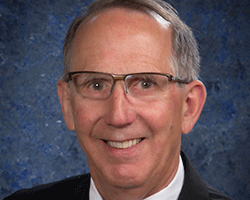
Success in ag lending hinges on a banker’s “passion for people,” says Dave Coggins, the Wisconsin banker who chairs the American Bankers Association’s Agricultural and Rural Bankers Committee.
Coggins learned the value of good people skills early in his career when he saw the impact to customers that resulted from one supervisor’s “sub-par” interactions. Learning, Coggins concludes, comes by observing those who are successful and those who are ineffectual.
As he was accepting the gavel as the ABA’s lead advocate for its ag-focused constituency, Coggins was also gearing up for a new career phase back in the dairyland. His bank, Manitowoc, Wis.-based Investors Community Bank, where he served as chief banking officer, was being acquired by Green Bay, Wis.-based Nicolet National Bank. The merger closed last December, giving the longtime banker a greater capacity to lend to increasingly larger agricultural operations. This need to be able to serve and compete with the likes of Farm Credit was part of the reason Investors Community Bank sought out a partner.
Farms outgrowing their lenders is not a new problem among rural banks, said Coggins, senior vice president of ag banking at Nicolet National Bank. No one wants to say we can’t serve you because of capacity, he said. But the problems brought through farm consolidation will continue, he predicted.
Coggins is encouraged by the credit conditions being reported by the nation’s ag banks. The ABA’s annual Farm Bank Performance Report showed the nation’s ag banks collectively increased agricultural lending by 5.5 percent in 2021 to $99.6 billion. The increase was driven by a 7.5 percent rise in outstanding loans secured by farmland and a nearly 3 percent increase in ag production loans.
Closer to home, the report shows that the 747 farm banks in the Corn Belt (Iowa, Illinois, Indiana, Michigan, Minnesota, Missouri, Ohio and Wisconsin) increased farm loans to $47.6 billion in 2021, a 6.61 percent increase from 2020. Agricultural production loans rose last year to $19.3 billion, up 3.94 percent from 2020, and farmland loans rose to $28.3 billion, up 8.5 percent from the previous year.
The 598 farm banks in the Plains region (Colorado, Kansas, North Dakota, Nebraska, New Mexico, South Dakota and Texas) increased their farm loans to $37.7 billion in 2021, up 4.45 percent or $1.6 billion from the year prior. Agricultural production loans rose 2.29 percent in that same period, $17.8 billion, while farmland loans increased 6.47 percent to $19.8 billion.
Farm banks in both regions experienced an increase in profitability in 2021.
Also on the rise are external pressures beyond the control of rural Americans. The war between Russia and Ukraine, while a boon to commodity pricing, is elevating the cost of fuel and fertilizer. “Managing margin becomes a critical thing for farmers today,” Coggins said. “They’ve always been focused on marketing products, but they have to get better on the input side.”
Weather is a perennial concern. Pointing to the 180-degree shift from drought to devastating floods in Montana recently, Coggins acknowledged that weather events are becoming more extreme.
The great challenge in the summer of 2022 is the Federal Reserve’s response to inflation and subsequent interest rate hikes. “This is something farmers haven’t had to deal with for a long time,” Coggins said. “Inflation is hitting all parts of the income statement.”
Farming tends to be a “survival of the fittest” endeavor, Coggins admitted. That’s reality speaking, not pessimism. Coggins understands that farming holds a revered spot in American lore; he uses words like “passion” and “loyalty” when talking about his 40-plus years of service to Wisconsin farmers.
“We don’t want to see farmers put out of business,” he said. “But they have to be good managers. Working hard is not enough.”
As discouraging as the external pressures might be, Coggins is encouraged by the industry’s ability to rise to the challenges of the day, and he encourages ag bankers to bring a passion for the people engaged in ag that is equal to the passion farmers bring to their work.
Coggins coaches young ag lenders to learn the technical side of ag lending, but to also foster a passion for farmers. Ag lending is not something you dabble in, the 68-year-old said. His career has been a continuous quest to learn more about his world, about banking and about agriculture. “It’s a thirst for knowledge.”
His time spent as chair of the ABA ag committee also reinforces his optimism. “There is good new blood. I’m encouraged in that regard. American agriculture is in a good place, and so are its ag banks.”
